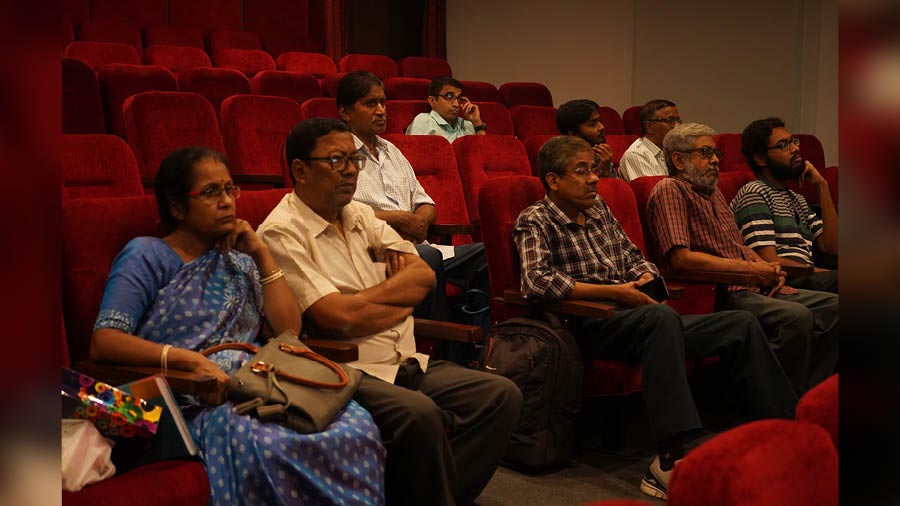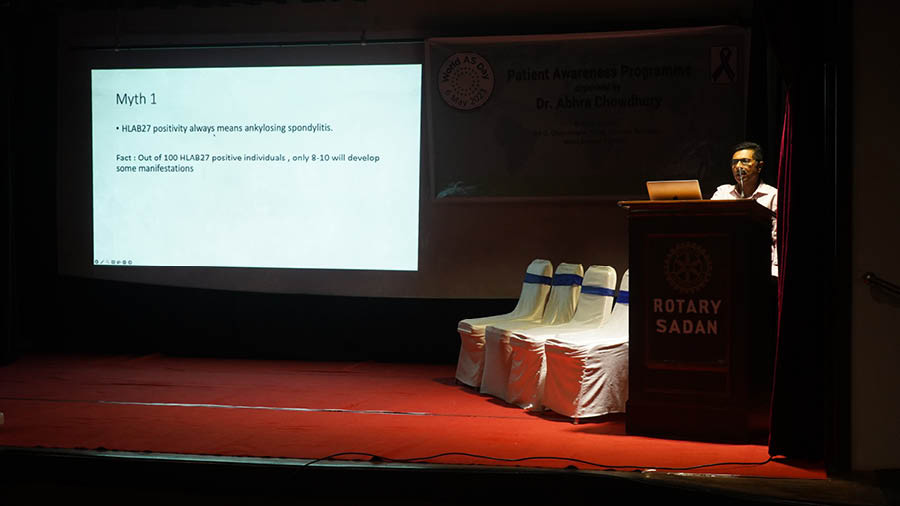World Ankylosing Spondylitis Day was observed at Rotary Sadan on May 6 with consultant rheumatologist Dr Abhra Chandra Chowdhury busting myths and speaking on treatment options that include exercise and lifestyle changes besides medication.
My Kolkata attended the patient awareness programme session and here’s all you need to know about ankylosing spondylitis.
What is Ankylosing Spondylitis?
“Ankylosing spondylitis is a spinal arthritis that develops in people who are between 20 and 40 years of age. It restricts mobility and may render them incapable. It is a fairly common disease but takes a long time to get diagnosed. There are some treatments for the disease if it can be detected at an early stage,” Chowdhury said.
Underlining the need for such a session, Chowdhury pointed out that there are several questions playing on the minds of patients and it is not always possible to answer every query during regular clinical sessions.

People attend the session at Rotary Sadan on Saturday Upama Dutta/My Kolkata
Primary symptoms
Asked about the primary symptoms of the disease, Chowdhury said: “Primary symptoms include lower back pain persisting beyond three months. Many may also experience early morning stiffness or increase in lower back pain at nights. Child patients (above 6 years) experience sudden swelling in joints. This disease also causes reddening of eyes and pain even if there are no other visible symptoms. It is a genetic disease. If a person in the family is detected with ankylosing spondylitis, the chances of other members of the family getting affected with it are quite high.”
However, the primary cause of delay in treatment is the delay in diagnosis is because one usually does not visit a rheumatologist for back pain. One visits an orthopaedic who does not suspect ankylosing spondylitis. This causes a major delay in the diagnosis and treatment.
Myth busting
The session took great care to bust some of the common myths associated with ankylosing spondylitis, dispel fears and present the actual facts. “A common myth is that HLAB27 positivity means ankylosing spondylitis. But HLAB27 is a gene that carries from one person to another. If you have symptoms like lower back pain, stiffness etc, then opt for an ankylosing spondylitis test.” said Chowdhury.
Similarly, “another myth is the disease needs lifelong medicines. But the fact is that if it is at a milder stage then exercise and intermittent painkillers will do the trick”.
In terms of lifestyle changes, many “think having ankylosing spondylitis does not allow a patient to marry or have children. Again, the fact is the disease being genetic, there is always a possibility of children developing the same; but it is a treatable disease if diagnosed early”.
Medication
Summing up the treatment, Chowdhury said: “Depending on what stage of the disease it has been detected, the milder cases can be treated by using painkillers and exercises. In some cases, an advanced form of medicine called biologics is required to keep the disease under control. Steroids are used only if one experiences swelling in joints.” Painkillers are the primary medicine in this case and some major facts about them include:
- Painkiller is the first and fast line of relief
- They can be consumed intermittently but first at least 2 weeks of continuous painkillers are required
- Painkillers are different for different patients, depending on what suits them
- A healthy patient can have painkillers for about four to eight weeks; anybody with liver ailments, above 50 years or obese can consume painkillers for 2-4 weeks
A second form of treatment includes biologics which are made from living cells. These are neither painkillers nor steroids but recombinant DNA technology.
Exercise is key
To maintain a healthy lifestyle despite having ankylosing spondylitis, it is advised a patient engages in some form of exercise regularly. There are a range of motion, stretching, aerobics, cardiovascular, strengthening exercises which one can engage in for reduce pain and increase mobility. Some key point to note while exercising includes the following.
- Do make time for exercise every day
- Do focus on good posture
- Do stick to your exercise consistency
- Don’t engage in only one form of exercise
- Don’t assume sports are off the list
- Don’t overdo exercises
Patientspeak
Jahid Hosen, a 29-year-old mobile technician from Rajarhat, was diagnosed with ankylosing spondylitis four months ago. “My hands and lower back become stiff and pain. The stiffness of my hands makes it difficult to work. Also, I cannot lift heavy weights. When my disease was diagnosed, my condition was bad but I am better off now with medicines.”
